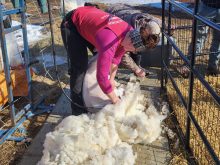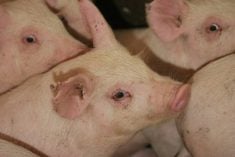A sharp rise in weanling prices has quieted plans for a piglet cull in Manitoba.
In early April, the threat of U.S. mandatory country-of-origin labelling (COOL) had pushed prices down to $5 per weanling, based on reports from Manitoba farmers.
At an April 3 meeting in Steinbach, Man., during the height of the price crisis, hog farmers proposed a cull of two million isoweans to significantly reduce numbers and prop up prices.
Recently, however, weanlings were selling in the $15 to $20 range and the cull proposal is no longer a hot topic.
Read Also

Charges laid after cattle theft
Saskatchewan RCMP lay two charges against a man after six cattle went missing.
“I don’t know of any isoweans that have been destroyed,” said Menno Bergen, who operates a hog barn near Plum Coulee, Man.
Bergen and Lloyd Wiebe, a hog farmer near Altona, Man., came up with the idea for the isowean cull, which received near unanimous support at the Steinbach meeting.
Since that time, Bergen said the weanling idea has taken a back seat while hog producers signed up for the federal government’s sow cull program. It pays farmers $225 per sow or boar euthanized.
“Guys have quit raising isoweans … so there’s been a lot of herd reduction,” said Bergen, who has not culled any of his sows, but added that several producers he’s talked to are clearing out their barns.
The rise in prices is welcome news, Bergen said, but that doesn’t mean hog farmers are now thriving.
“The sad news is that we have raised the bar to where we are only losing half as much as we did before,” he said, adding that with the high cost of feed, farmers need at least $40 per weanling to be profitable.
Harold Rempel, who raises isoweans in the Steinbach area, is feeling more optimistic.
“When you sell a three-week-old pig, it usually goes to market in about five or six months …. So when we’re selling isoweans in July, we’re selling off January 2009 pricing,” said Rempel, who co-owns ProVista Agriculture with his brother, Arthur.
With 2009 lean hog futures now more than $80 a hundredweight, things are looking more hopeful for weanling producers, Rempel said.
“There’s some optimism that come July or August, there will be decent prices (for isoweans),” he said.
The rise in piglet prices is surprising given that American feeder pig operators were, only a few weeks ago, cancelling contracts with Manitoba isowean producers.
According to reports from Manitoba farmers, the U.S. buyers said they could no longer purchase Canadian piglets because COOL would soon be a reality.
COOL, part of the U.S. farm bill, will require that animals be born, raised and slaughtered in the U.S. if the meat is to be labelled “made in the U.S.A.”
American producers said they didn’t want Canadian weanlings in their barns because they didn’t want to get caught with pigs that couldn’t be slaughtered without additional labelling.
The idea that COOL was solely responsible for depressing prices, may have been overblown, Rempel said.
“Even U.S. producers selling three-week-old pigs have been getting very poor prices,” he said. “So there’s a bit of a debate on the true impact of COOL.”
Although the U.S. farm bill will soon be law, it’s uncertain what that will mean for Canadian hog farmers.
“In terms of language (in COOL) it’s roughly what we talked about all winter long,” said Andrew Dickson, general manager of the Manitoba Pork Council, adding their lawyers are studying the wording.
“It’s the interpretation of the wording that becomes the issue …. This is going to get complicated.”
In the face of the pending reality of COOL, Rempel said at least Canadian hog farmers will soon know what they’re up against.
“We’re very confident that we can adapt to (the COOL regulations) and abide by them,” he said.

















